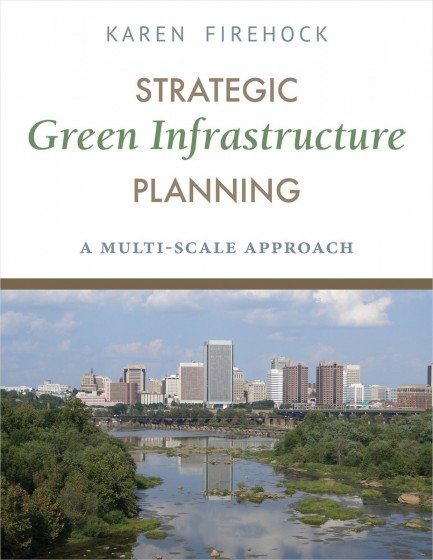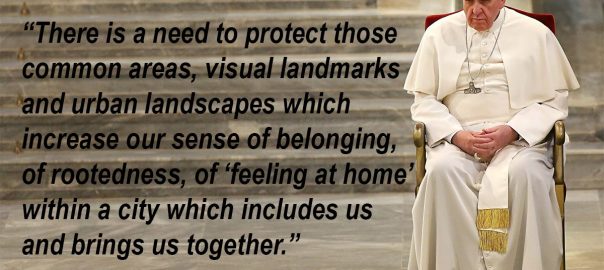A review of Strategic Green Infrastructure Planning: A Multi-Scale Approach, by Karen Firehock, with chapter seven by R Andrew Walker. 2015. ISBN 978-1-61091-692-9. Island Press, Washington. 138 pages. Buy the book.
Almost everyone knows what urban greening looks like and how much we need it in everyday life, but few understand why we need to think about and manage it as “green infrastructure,” also called GI.
This new term emerged as a way to recognize that green areas have many different values to people, providing real and intangible environmental, social, and economic benefits. In the urban matrix, green areas are as important as grey infrastructure and need to be handled and cared for with expertise.
This statement is not at all exaggerated considering that GI forms part of the daily life of a community. It protects water supply, prevents flooding and landslides, filters polluted air and impaired waters, preserves biodiversity, mitigates climate change through carbon sequestration, improves climatic comfort and public health, gives opportunities for recreation, and preserves historic or scenic landscapes. It also increases property values.
Using her wealth of experience, Karen Firehock offers fresh insights into community GI planning, addressing existing ideas of the need to connect green/blue and grey landscapes as well as fields of different disciplines (planning, landscape architecture, forestry, ecology, transportation, health). She does so through a concise, well-illustrated, and easy to read manual.
Like other approaches that envision green infrastructure from the standpoint of environmental services, this report defines it as an environmental insurance policy that enables traditional economic growth and development without compromising the well-being of the community.
 The book guides the reader in deciding what landscape features are important to preserve or to restore, and how to do it step by step, emphasizing the need to set goals, review data, make maps, assess risks, and determine and implement opportunities. When creating a GI strategy, one needs to identify and evaluate existing natural and cultural resources, prioritizing those that are distinctive or that best meet current and future needs.
The book guides the reader in deciding what landscape features are important to preserve or to restore, and how to do it step by step, emphasizing the need to set goals, review data, make maps, assess risks, and determine and implement opportunities. When creating a GI strategy, one needs to identify and evaluate existing natural and cultural resources, prioritizing those that are distinctive or that best meet current and future needs.
In seven chapters, the authors present an overview of GI planning and a short introduction of the terms commonly used to describe GI (Chapter 1), the reasons to undertake a GI planning process (Chapter 2), and the steps required to organize initiatives at multiple scales with the engagement of different stakeholders (Chapter 3).
Chapter 4 is the key chapter, where readers can find over 40 pages on how to create a GI strategy that is easy to implement. Chapter 5 is devoted to examples from the United States at multiple scales, beginning with a region, scaling down to a county, then a city, and ending with a local watershed in Virginia. At the regional scale, the book shows how Richmond’s Regional Priority Map was created as a collaborative project bringing together local governments, state and federal agencies, and civil organizations. The map identifies natural corridors along rivers is a key tool for future planning and management. At a county scale, the authors describe how a GI map was created for New Kent in Virginia based on field visits and interviews with diverse stakeholders. The city scale example shows how to work in detail with smaller watersheds, streets, pocket parks, community gardens, parcels, and tree canopy, which can become important landscape features.
The importance of engaging residents and planners to guarantee the success of the project is well developed in Chapter 6. Firehock gives options and ideas on how to build community support, along with examples of key messages. By means of 13 short statements, she shows how to get to the heart of the argument that potential GI-implementers wish to make about the benefits of doing their proposed projects. With several examples, the key messages show how many communities are doing, and having success with, strategic GI planning. They address issues linked to personal finance, investment, property values, jobs, recreation and businesses, quality of life, ecological reasons, conservation areas, and social benefits.
The book ends with guidance by R Andrew Walker for creating themed maps, including relevant data and metrics for natural infrastructure (Chapter 7).
Strategic green infrastructure planning: A multi scale approach is the result of many years of work by the Green Infrastructure Center, an NGO which advises governmental agencies and communities on how to manage development with the conservation of natural assets, where the author is director and the co-author is a GIS analyst and spatial planner.
This guide addresses a wide audience: planners, developers, city managers, landscape architects, architects, scientists, and others interested in how and where to develop or conserve land. Its simple and pleasant writing makes it valuable for professors, students, citizen groups, and conservationists. The examples given from the U.S. are applicable worldwide.
It is a useful book that provides tools and tips, and I strongly recommend it.
Ana Faggi
Buenos Aires
You can support TNOC (and the book’s authors) by buying the book via this link.












Add a Comment
Join our conversation